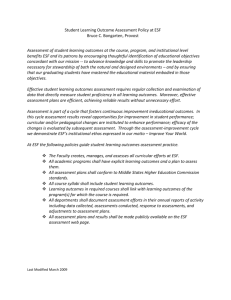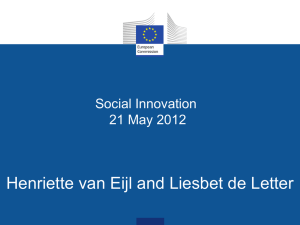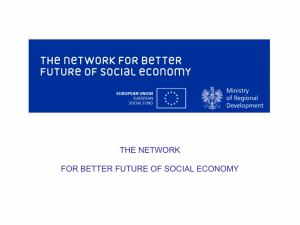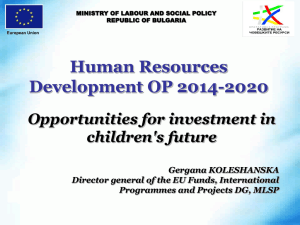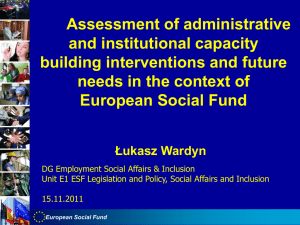The EU Employment Policy
advertisement
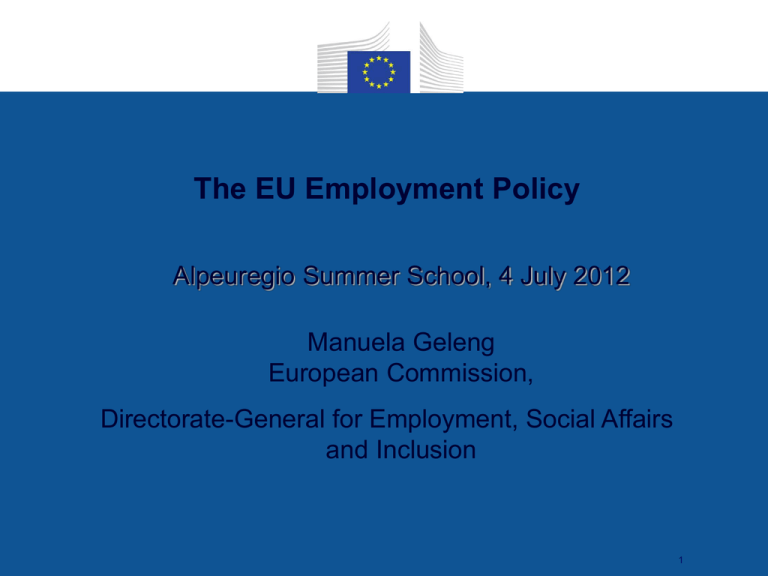
The EU Employment Policy Alpeuregio Summer School, 4 July 2012 Manuela Geleng European Commission, Directorate-General for Employment, Social Affairs and Inclusion 1 Outline • Introduction: Why an EU employment policy? • Instruments • Challenges • EU-2020 and the future of the EU employment policy 2 Why an EU Employment Strategy? • • • • Ensuring the 4 fundamental freedoms compensating the effects of the internal market Implementing common standards of labour protection Europe as an economic area with a common labour supply (labour market participation of women, older workers and by level of education) • Implementing common values (anti-discrimination, gender equity) • Counterbalancing short term national policies (e.g. reducing budget cuts • Improving the effectiveness of administrations, especially in smaller countries necessity of a coordinated policy for the common challenges in a common economic area Instruments of the EU Employment Policy Four forms of EU governance: 1. Through legislation (e.g. directives on free movement of workers, coordination of social systems, health and safety) 2. Through negociations between social partners on EU-level in the Social Dialogue (introduced in Maastricht 1993) 3. Through the Open Method of open coordination (OMC) introduced in Nice (2002), (first applied for the European Employment Strategy, introduced in Amsterdam 1999) and extended to new areas: social inclusion (2000), education/training (2000), pension, health/long-term care (2005) 4. Through the European Social Fund introduced 1957 The four instruments of EU Employment Policy Legislation Open Method of Coordination EU Employment Policy European Social Dialogue European Social Fund 1. EU governance through legislation Subsidiarity principle: Employment and social policy are national affairs but derogations: • Occupational health and safety • Information and consultation of workers • Labour law and working conditions 2. EU governance through social dialogue • Social partners can fix Europe-wide agreements through the social dialogue • Legal base: articles 154 and 155 of the Treaty on the Functioning of the European Union - TFEU • Social partners can propose and introduce legislation through consultations, negotiations and finally common positions (more than 300 legislative texts so far) • Policy advice for legislation 3. EU governance through the open method of coordination (OMC) Steps of OMC for employment and social protection • Common goals for the EU and its Member States • Common indicators in order to measure progress • Translating EU goals in national/regional policies: national strategies for social protection and social inclusion • Yearly reports on the progress in the Member States and based on this: National Reform Programmes • Exchange of experience between Member States (identifying best practices) • Close cooperation between European Commission and Member States through Employment Committee and Social Protection Committee 4. EU governance through the European Social Fund (ESF) Total EU budget (2007-13): roughly 988 Mrd. € ESF: 76 Mrd. € (roughly 10 Mrd. €/year) andere EUAusgaben 64% ESF 8% EFRE & Kohäsionsfond 28% The ESF in the European context: distribution of funds 314 Mio. inhabitants (65%) € 55 Mrd.(16%) 170 Mio. inhabitants (35%) € 283 Mrd (81,5%) The ESF in the context of structural funds: objectives and funds objective funds convergence EFRE ESF Regional competitiveness & employment EFRE ESF European territorial cooperation EFRE infrastructure, innovation, investments qualifying people, social inclusion All Member States & regions cohesion fund environment, transport, renewable energy Member States GDP/capita < 90% ESF priorities 2007-2013: adaptability of workers & enterprises access to employment 4% 13% €10bn 3% 1% 18% human capital social inclusion institutional capacity 28% partnerships Other 33% Common challenges in almost all Member States: • Demographic change and its impact on pension and health systems • Unemployment today – shortage of workforce tomorrow? • Youth unemployment • Migration • Poverty and social exclusion • New world of work with social interaction through new technologies • Impact of the economic crisis EU2020 – 3 interlinked priorities Smart growth: developing economy based on knowledge and innovation Sustainable growth: promoting more efficient, greener & more competitive economy Inclusive growth: fostering high-employment economy delivering social & territorial cohesion EU2020 strategy 5 EU headline targets by 2020: 1. 75% employment rate (20-64 years) 2. 3% of GDP for Research & Development 3. "20/20/20" energy efficiency 4. Less than 10% early school leavers and at least 40% of the younger generation with a tertiary degree attainment 5. 20 million poor people less Increasing labour market participation All regions have to increase their employment rates The convergence regions have a high unemployment rate and need more than 10 million jobs in order to reach the objective – more than all the other regions Improving eductional attainments Fighting poverty and deprivation Poverty concerns all Member States Serious material deprivation is concentrated in the less developed Member States Deprivation is concentrated in urban areas in EU-15 and in rural areas of EU-12 Europe 2020 – next steps (1) 1. Reshaping the EU Employment Policy Focussing on qualifications Rebalancing flexibility and security Fighting against youth unemployment 2. supporting the social dialogue & enhancing individual responsibility 3. improving employment legislation, especially: Regulating working time Posting of workers Europe 2020 – next steps (2) 1. Modernising the social security systems, especially developing long-term care - and social services stablising the pension systems (white book) portability of pensions 2. fighting against poverty and social exclusion especially child poverty 3. dealing with employment and social issues related to migration More information: http://ec.europa.eu/eu2020/ http://ec.europa.eu/social/ http://ec.europa.eu/employment_social/esf/ Thank you for your attention! 21
